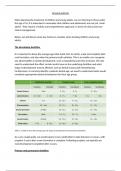Growing patients
When planning the treatment of children and young adults, we are referring to those under
the age of 16. It is important to remember that children and adolescents are not just ‘small
adults’. They require a holistic and comprehensive approach, in terms of clinical and non-
clinical management.
Below, we will discuss some key factors to consider when treating children and young
adults.
The developing dentition
It is important to know the average ages that teeth start to calcify, erupt and complete their
root formation, and also when the primary teeth exfoliate. This is to enable us to recognise
any abnormalities in dental development, such as hypodontia and infra-occlusion. We also
need to understand the effect certain insults have on the underlying dentition and what
stage of development may be affected, such as dental trauma and chemotherapy.
Furthermore, to correctly identify a patients dental age, we need to understand what would
constitute appropriate dental development for their age group.
Calcification (months) Eruption (years) Root completion (years)
Maxillary Mandible Maxillary Mandibular Maxillary Mandibular
Central incisors 3-4m 7-8y 6 -7 y 9 – 10 y
Lateral incisors 10 – 12m 3 – 4m 8-9y 7-8y 11 y 10 y
Canines 4-5 12 - 12 y 9 - 11 y 12 – 15 y
First premolars 18 – 24m 10 - 11 y 10 - 12 y 12 – 13 y
Second premolars 24-30m 10 - 12 y 11 - 13 y 12 – 14 y
First molars Birth 5.5 - 7 y 5.5 - 7 y 9-10 y
Second molars 30-36m 12 - 13 y 12 - 14 y 14 – 16 y
Third molars 7-9 y 8 - 10 y 12 - 30 y 17 - 30 y
Table 1: A table to show the average age and stages of development in the permanent dentition.
As a very rough guide, we would expect crown calcification to take between 2-4 years, with
eruption 3 years after crown formation is complete. Following eruption, we typically see
root development completed after 2 years.
Primary and permanent dentition
, There are many differences between the primary and permanent dentitions. For these
reasons, dental diseases, and dental anomalies may present differently, leading to different
treatment options. This also mean we may manage similar diagnoses in different ways,
depending on whether it is a primary or permanent tooth.
Differences between primary and permanent teeth - primary teeth:
Roots: Enamel
- Thin - Less calcified
- Delicate Pulp
- Longer in comparison to crown - Thinner dentine
- High furcation - Wide pulp canal
- Widely divergent - High pulp horns
- Vascular
Restoration of the primary dentition
When it comes to restoring the primary dentition, there are several different approaches,
many of which have a sound evidence-base. It can often be difficult to decide which option
is best, and we need to consider other factors too, such as caries-risk, cooperation, and
symptom history.
1) Preventative approach
- Using excellent toothbrushing, fluoride adjuncts and dietary changes to arrest caries
and prevent progression.
2) Hall technique
- The use of preformed metal crowns to seal in caries, without any caries removal or
tooth preparation.
3) Partial caries removal
- Soft caries is removed prior to restoration.
4) Complete caries removal
- A traditional way of restoring caries, much like in the permanent dentition.
5) Pulpotomy
- Amputation of infected pulp, leaving the remaining healthy pulp intact.
Hall technique
In the UK, this is a popular option for restoring primary molar teeth. The technique is well-
researched, and its success is well-documented in many peer-reviewed journals. When
cases are selected appropriately, it is extremely successful in arresting caries, preventing
pain and infection, and maintaining the tooth until exfoliation.
Indications Contraindications




